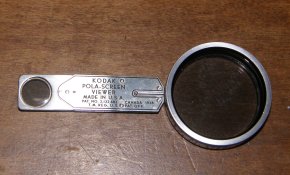NB23
Member
- Joined
- Jul 26, 2009
- Messages
- 4,307
- Format
- 35mm
Over time we’ve all had to resort to clever, and sometimes silly, tricks in order to overcome problems. Use of the imagination and voila!
I am presently in the middle of a decade long intense printing marathon which consists of printing all my worthy BW shots. I don’t want to add any more BW films to the process or I risk never getting out of the darkroom. This is why I have decided to shoot color, at least for the next 100 rolls.
Now this is the problem: I shoot XPAN, Leica and Rolleiflex. I’ve shot an insane amount of Kodachrome until 2010... but all without a polarizing filter. This was a shame because a polrizer would have benefited 100% of the images, one way or another. I do not want to do the mistake again, and I don’t want to resort to silly manoeuvres of constantly unscrewing and re-screwing filters.
So I sat down and thought hard for 2 minutes. And I understood how stupid I have been for all those lost years.
The good way to easily and effectively use a circular polarizing filter with your Leica and Rolleiflex is....... to have one attached on the lens, and another one (a junker) in your back pocket.
Calibrate both filters with a nailpolish dot on the position they both match. And voila. Look through the one in your hand, match the dot on the lens.
Jeezakrice. Where was my brain all this time?
I am presently in the middle of a decade long intense printing marathon which consists of printing all my worthy BW shots. I don’t want to add any more BW films to the process or I risk never getting out of the darkroom. This is why I have decided to shoot color, at least for the next 100 rolls.
Now this is the problem: I shoot XPAN, Leica and Rolleiflex. I’ve shot an insane amount of Kodachrome until 2010... but all without a polarizing filter. This was a shame because a polrizer would have benefited 100% of the images, one way or another. I do not want to do the mistake again, and I don’t want to resort to silly manoeuvres of constantly unscrewing and re-screwing filters.
So I sat down and thought hard for 2 minutes. And I understood how stupid I have been for all those lost years.
The good way to easily and effectively use a circular polarizing filter with your Leica and Rolleiflex is....... to have one attached on the lens, and another one (a junker) in your back pocket.
Calibrate both filters with a nailpolish dot on the position they both match. And voila. Look through the one in your hand, match the dot on the lens.
Jeezakrice. Where was my brain all this time?




